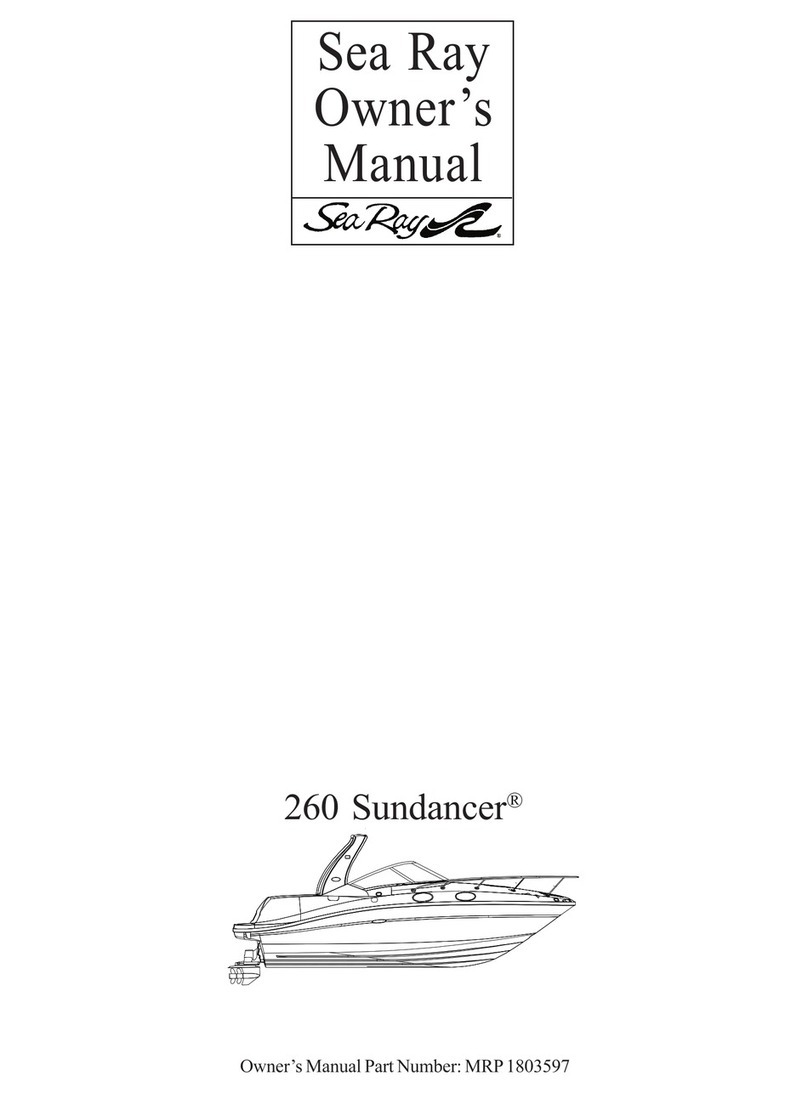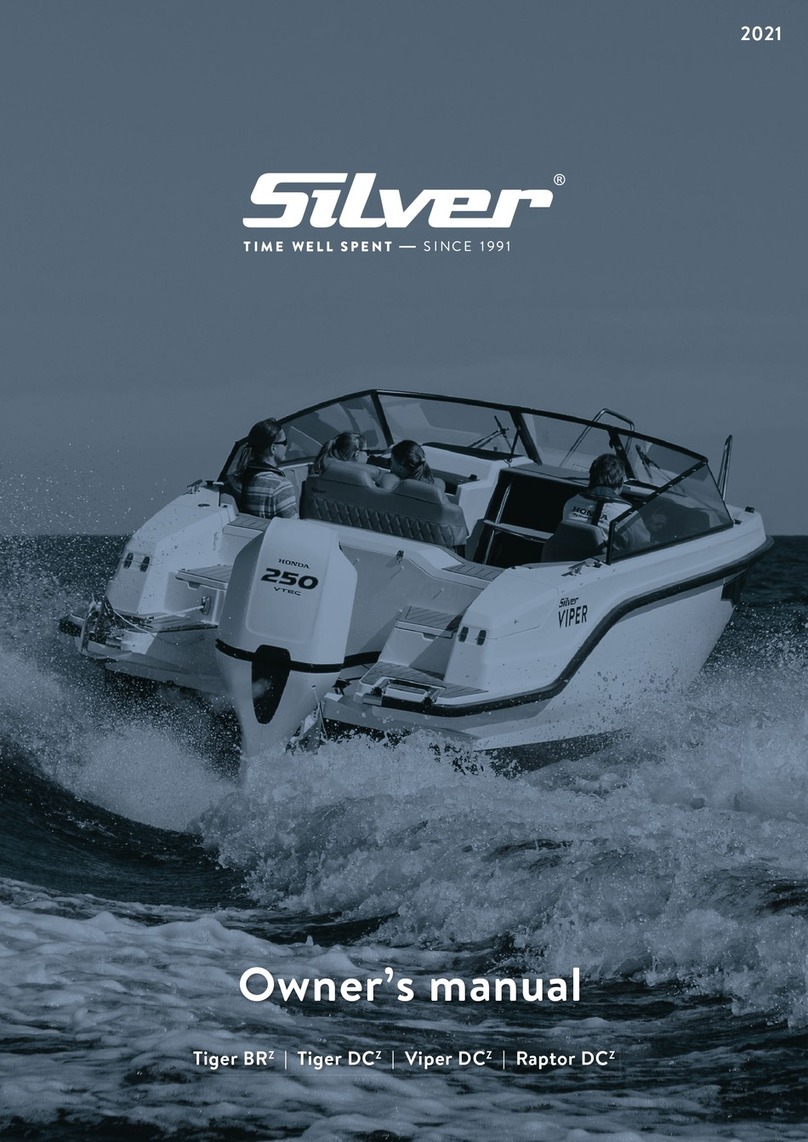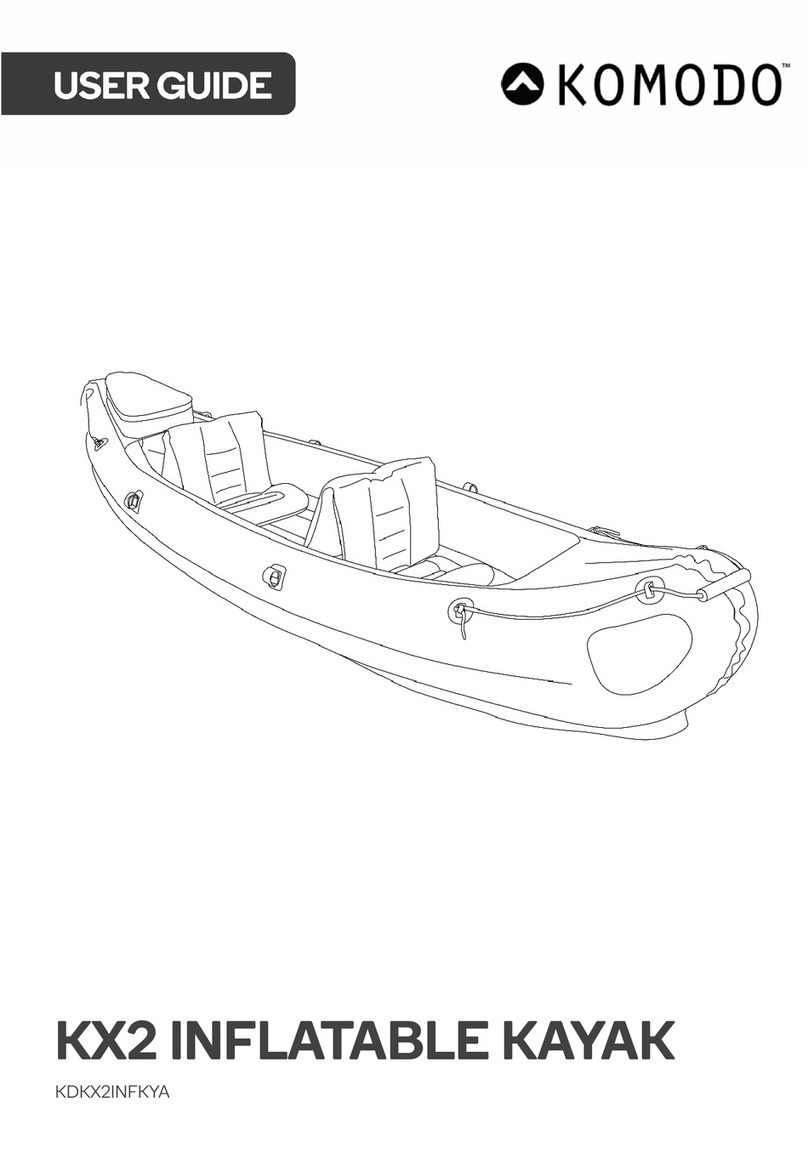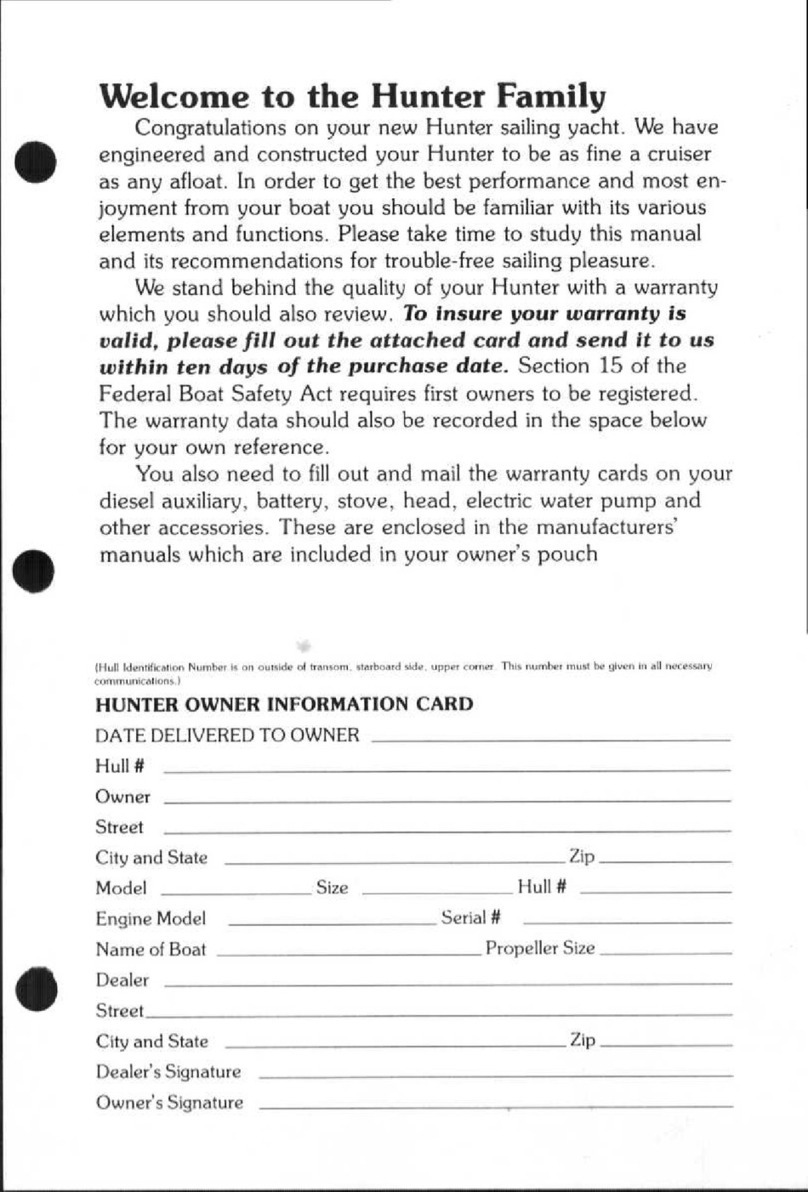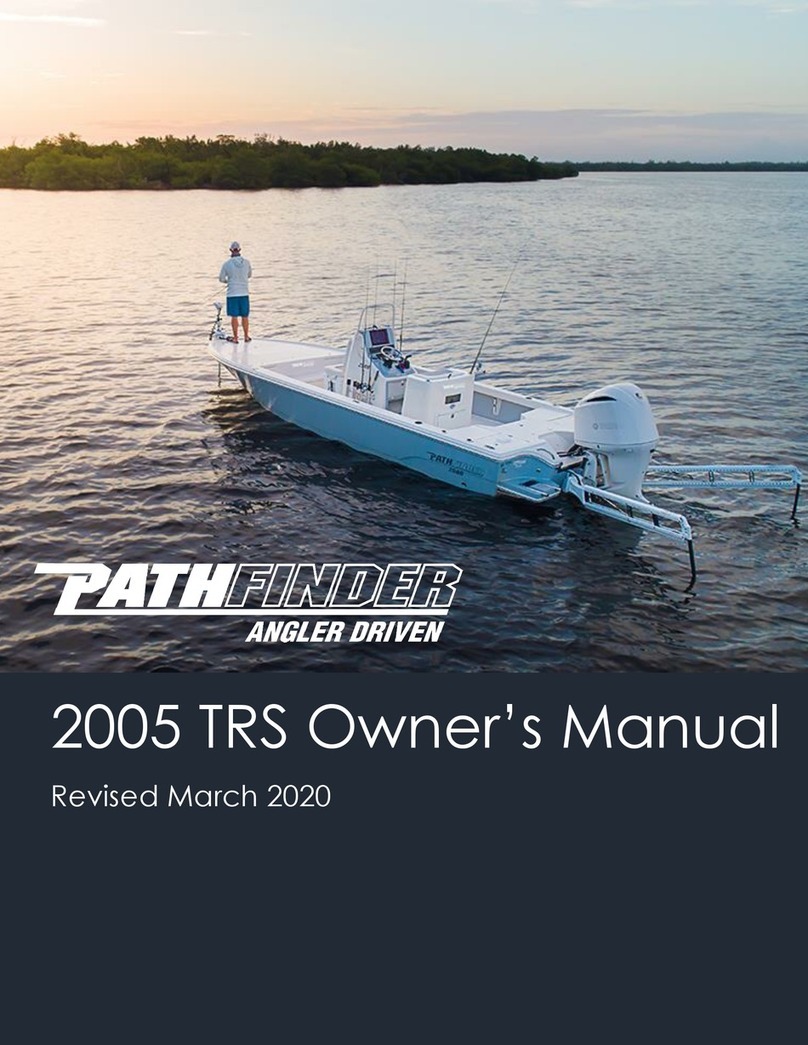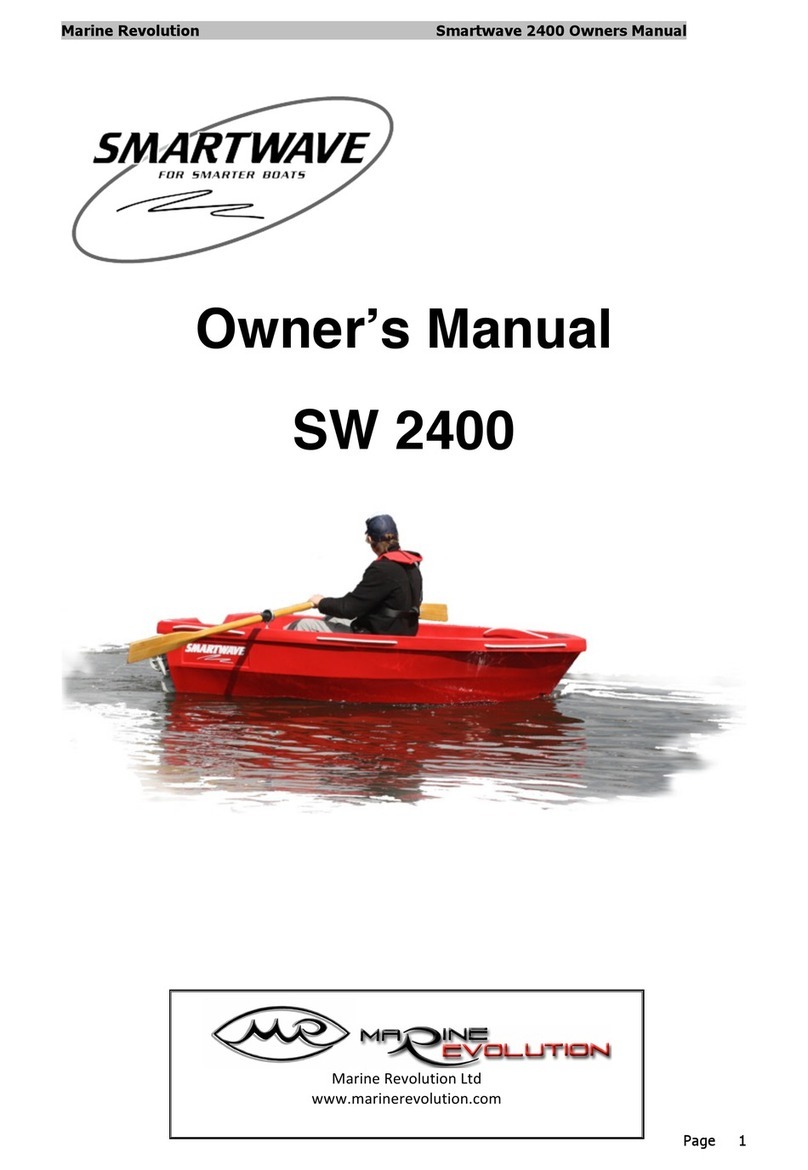RNLI Atlantic 85 User manual

B CLASS
ATLANTIC 85
MANUAL

B CLASS
ATLANTIC 85
MANUAL

This handbook is dedicated to all those who strive
to fulfil the purpose of the RNLI: To save lives at sea.
We would like to express our sincere gratitude to the volunteers and staff
across the RNLI, who have contributed to the production of this publication.
Stores Item: TP-LB-23
First Issue – June 2017
NOTE: This printed document is deemed correct only for date of issue.
For the most current version, refer to the Learning Zone.
© Copyright RNLI 2017.
No part of this publication may be produced or transmitted in any form, or by any means, electronic or
mechanical, including photocopying, recording, or by any information storage or retrieval system, without
permission from the RNLI. Although every effort is taken to ensure the content of this publication is accurate,
the RNLI cannot take responsibility for any incorrect action taken, or not, due to errors or omissions
B CLASS
ATLANTIC 85
MANUAL


Contents
B Class Atlantic 85 Manual – First Issue, June 2017
5
Contents.................................................................................... 5
Welcome ................................................................................... 9
Degree of hazard safety labels............................................ 10
Activity 2 – Personal Competencies
SAR unit firefighting.............................................................. 12
Engine fires.......................................................................... 12
Electrical fire in the console............................................. 12
Emergency and survival procedures................................... 13
Heavy weather considerations........................................ 13
RNLI crew seats.................................................................. 13
Atlantic 85 layout - plan view............................................. 14
Atlantic 85 layout - side view.............................................. 15
Atlantic 85 layout - consoles .............................................. 16
MOB (man overboard)...........................................................17
Capsize......................................................................................17
Engine starting procedure ............................................... 18
Post capsize procedure ..................................................... 18
Sea anchor .............................................................................. 19
Engines.....................................................................................20
Water ballast .......................................................................... 21
Ballast control lever (waterscoop) ................................. 21
Bow to stern fixtures, fittings and stowage .....................22
Fairlead ................................................................................22
Sea anchor stowage ..........................................................22
Anchor stowage .................................................................22
Bailey hatches.....................................................................22
Bow cleats...........................................................................23
Bow lifting points...............................................................23
Anchor warp stowage .......................................................23
Red flare and knife stowage.............................................23
Torch stowage ...................................................................23
Battery compartment.......................................................24
Throttles..............................................................................24
Communications unit .......................................................24
Battery isolator ..................................................................25
Distribution box .................................................................25
Navigation and communications equipment...............26
Chart light and MOB alarm..............................................26
White flare stowage ..........................................................26
Fuel tanks ............................................................................26
Fuel change-over blocks...................................................26
Under seat stowage........................................................... 27
Throw bag stowage ........................................................... 27
MOB (man overboard) cord............................................. 27
Fourth seat stowage.......................................................... 27
Aft lifting points................................................................. 27
Tow line stowage ...............................................................28
Emergency steering bypass valve ...................................28
A-frame and cleats ............................................................28
Capsize bag .........................................................................29
PS1 stretcher.......................................................................29
Camera.................................................................................29
Towing bar and straps.......................................................30
Emergency antenna connection .....................................30
Directional finder (DF) and mast ....................................30
Activity 3 – Launch and Recovery
Launch and recovery .............................................................32
Launch..................................................................................33
Types of Atlantic launch and recovery...........................34
Drive on - Drive off (DO-DO) launch.........................34
Davit launch....................................................................34
Drive on - Drive off floating dock................................34
Slipway.............................................................................34
Hydrohoist ......................................................................35
Bedstead..........................................................................35
Carriage and winch ........................................................35
Lorry with mobile crane................................................35
Post recovery ......................................................................36
Activity 4 – SAR Unit Handling
and Seamanship
Helming the Atlantic 85.......................................................38
Helm console layout.........................................................38
Technical specification......................................................39
Starting and stopping engines.........................................40
Throttles and gear selection............................................40
Ballast system ....................................................................40
Emergency steering (see page 100 )...............................40
Berthing and mooring........................................................... 41
Berthing .............................................................................. 41
Considerations when berthing .................................... 41
Preparations for berthing ............................................. 41
Stern/bow lines .............................................................. 41
Springs.............................................................................. 41
Approaching the berth .................................................42
Wind/tide coming from ahead ....................................42
Wind/tide coming from astern....................................42
Wind/tide coming from berth .....................................42
Leaving the berth ...........................................................42
Mooring ...............................................................................43
Mooring to a buoy .........................................................43
Considerations when mooring ....................................43
Anchoring................................................................................44
Deployment........................................................................44
Paying out and securing....................................................44
Extending the line .............................................................44
Veering.................................................................................45
Recovery ..............................................................................45
Towing .....................................................................................46
Astern tow...........................................................................46
Alongside tow.....................................................................47
Atlantic 85 working with helicopters.................................48
Static transfers ...................................................................49
Hi-line...............................................................................49
Underway/formatting transfer .......................................50

Contents
B Class Atlantic 85 Manual – First Issue, June 2017
6
Activity 5 – Search and Rescue
Locate and assist casualty....................................................52
Search methods and equipment.....................................52
Radar ................................................................................52
Illuminating flares (pyrotechnics)...............................52
Binoculars/image intensifiers ......................................52
Searchlights.....................................................................53
Visual scanning techniques ..........................................53
Effective lookout............................................................53
Systems and information management system
(SIMS)...............................................................................54
Ambulance pouch ..........................................................54
Throw bag........................................................................54
Casualty recovery ..................................................................55
Conscious recovery............................................................55
Body Recovery....................................................................55
The RNLI PS1 stretcher .....................................................56
Safety considerations....................................................56
Activity 6 – Communications
Crew communications and control units..........................58
Helm, crew 2 and crew 3..................................................58
Crew 4..................................................................................59
Additional features............................................................59
Crew helmets......................................................................59
Sailor 6215 VHF DSC radio ..................................................60
SAILOR 6215 VHF DSC display........................................ 61
General use and navigation ............................................. 61
Power on and speaker volume..................................... 61
Working channel, settings and dim function ............ 61
Adjusting the squelch.................................................... 61
Channel 16 ...................................................................... 61
Replay button ................................................................. 61
DSC distress alert button ............................................. 61
Hi and low power........................................................... 61
Scan of tagged channels ...............................................62
DSC operation ....................................................................62
SCAN TAG operation.........................................................62
Function dial for radio, conferencing and mic..............62
Fist mic.................................................................................62
ICOM IC-M423G VHF marine transceiver........................63
ICOM IC-M423G function display..................................64
ICOM IC-M423G softkey function.................................65
Softkey function selection ...........................................65
Making a Distress call........................................................65
Simple call.......................................................................65
Speaker microphone (fist mic) ........................................66
Activity 7 – Navigation
Navigation package...............................................................68
Start up of RNLI SIMS .......................................................68
SIMS functions....................................................................68
RNLI SIMS handheld controller...................................68
Day/night palette and brightness...............................69
Radar ................................................................................69
Shut down of RNLI SIMS...............................................69
Further reading...............................................................69
Activity 9 – Propulsion and Auxiliary Systems
Yamaha F115 outboard engines .......................................... 72
Engine specification (F115A/OE 33)............................... 72
Engine layout (F115A/OE 33 main views) ..................... 73
Electronic control system .................................................... 75
Sensors, switches and actuators..................................... 76
Engine control unit (ECU) F115 (OE 26)........................ 77
Engine control unit (ECU) F115A (OE 33) .....................78
Air induction system.............................................................79
Capsize modification.........................................................79
Ecapsize testing ..............................................................79
Idle speed controller (ISC) ...............................................80
Engine fuel system................................................................. 81
Electronic fuel injection system......................................82
Engine electrical system.......................................................83
Polyswitches .......................................................................84
Charging systems...............................................................84
Regulator/rectifier .............................................................84
Pulser coil ............................................................................85
Ignition coil .........................................................................85
Spark plugs:.........................................................................85
Spark plug testing ..............................................................85
Ignition control...................................................................85
Cooling system ......................................................................86
Cooling system flow chart ...............................................87
Engine thermostat.............................................................87
Pressure control valve (PCV) ...........................................87
Water pump........................................................................88
Changing the Impeller...................................................88
Lubrication system................................................................89
Trim/tilt unit...........................................................................90
Gearbox assembly ................................................................. 91
Changing the oil ............................................................. 91
Re-filling........................................................................... 91
Removing the gearbox .................................................. 91
Propeller ..................................................................................92
Propeller safety notice......................................................92
Changing a propeller due to damage .............................92
Removal of the propeller..............................................92
Fitting a new propeller..................................................92

Contents
B Class Atlantic 85 Manual – First Issue, June 2017
7
On-board fuel system...........................................................93
On-board electrical system.................................................94
Batteries ..............................................................................94
Battery charging.................................................................94
Isolation box .......................................................................95
Circuit breaker ................................................................95
Changing the circuit breaker........................................95
Engine instrumentation and control..............................96
Loom junction box.........................................................96
Engine control panel......................................................96
Steering system ..................................................................... 97
‘Seastar’ hydraulic steering system................................ 97
Maintenance of the steering system..............................98
Bleeding the hydraulic steering system.........................99
Emergency steering system...........................................100
Emergency tiller arm ...................................................100
Operating the Atlantic 85.................................................. 101
Engine pre-start checks .................................................. 101
Monitoring the engines................................................... 101
Recognising changes in engine performance ......... 101
Engine parameters....................................................... 101
Engine alarms ...................................................................102
Fuel contamination alarm..........................................102
Engine overheat alarm ................................................102
Stopping the engines.......................................................103
Emergency engine stop...............................................103
Engine malfunction/failure ............................................103
Digital tachometer.......................................................103
Fuelling procedure ...........................................................104
Dealing with fuel spillages .............................................104
Salvage pump.......................................................................105
Engine specification (Honda WX10).............................105
Post recovery checks.......................................................105
Dos and don’ts of machinery safety for workers...........105
Activity 10 – Planned Maintenance
Planned maintenance .........................................................108
SIMS maintenance...........................................................108
Activity 11 – Unplanned Maintenance
Yamaha F115 outboard engine .......................................... 110
Engine will not start............................................................ 110
Basic fault finding............................................................. 110
Intermediate fault finding .............................................. 110
1, 2, 3 Procedure........................................................... 110
Engine stalls.......................................................................111
Spark testing......................................................................111
Defective spark plugs...................................................... 112
Engine rough idling.......................................................... 112
Engine poor performance............................................... 112
Hull construction and repair.............................................. 114
Construction..................................................................... 114
Repair ................................................................................. 114
Buoyancy tubes.....................................................................115
Design and function .........................................................115
Tube repairs .......................................................................115
Tube repair procedure ................................................. 116
Inflation valve repair procedure ................................ 116
Ballast system .......................................................................117
Overview ............................................................................117
Lever/cable installation ...................................................117
Adjustment of the system.......................................... 119
The B-Class Atlantic 85 self-righting system................. 119
Overview ........................................................................... 119
On-board mercury switch..............................................120


Welcome
B Class Atlantic 85 Manual – First Issue, June 2017
9
Welcome
The Atlantic 85 class lifeboat is a brilliant example of a diverse, robust and capable inshore lifeboat. It has the
ability to enable RNLI lifesavers to undertake search and rescue activities, in a wide range of environments
and situations. Quite simply, if we can’t get our lifeboats to casualties in a safe and effective manner, we
won’t rescue people. The Atlantic 85 class lifeboat, together with the wide range of launch and recovery
systems, is strong, built for purpose and an effective rescuing tool, helping to ensure that the diverse needs
of the people you rescue are met.
However, all that means nothing if it is not handled properly, maintained well and its operation not
controlled safely. That is why your role, whether operating or maintaining the Atlantic, is so important.
These astonishing pieces of equipment will only remain this good and operate safely if you carry out your
vital role.
This manual is here to support you, providing the guidance needed to carry out your tasks.
I hope that you will find it helpful in providing the underpinning knowledge about this equipment.
Thank you for your commitment to the organisation and for taking on this responsibility. It really is important
and really is appreciated.
Leesa Harwood
Community Lifesaving Director

Informative Labels
B Class Atlantic 85 Manual – First Issue, June 2017
10
Dangers, Warnings, Cautions
Depending on the severity of harm associated with a
person, craft or component, or to the environment, hazards
are identified through the use of different labels. Starting
with the highest severity first, you will see DANGER,
WARNING and CAUTION labels throughout this manual.
An example of each is detailed below.
Procedure labels
A list of emergency operating procedures (EOPs),
standard operating procedures (SOPs) and local operating
procedures (LOPs) can be found on the RNLI Intranet
through Horizon. At various points through this manual,
you will find some of these labels that will give details on
which procedure to reference on Horizon. An example of
each type of procedure label is detailed below.
Emergency operating procedure
An emergency operating procedure (EOP) is a set of step-
by-step instructions for RNLI personnel to carry out in the
event of a situation that has potentially disastrous results.
An example of an EOP label is shown below:
Emergency operating procedure
EOP
Standard operating procedure
A standard operating procedure (SOP), is a set of step-
by-step instructions for RNLI personnel to carry out
routine operations. SOPs aim to achieve efficiency, quality
output and uniformity of performance, while reducing
miscommunication.
Standard operating procedure
SOP
Local operating procedure
A local operating procedure (LOP), is a set of step-by-
step instructions for RNLI personnel to carry out routine
operations specific to a locality. Examples of this could be
a lifeboat station or a lifeguarding facility.
Local operating procedure.
LOP
WARNING
Denotes that a hazard exists which can result in
injury or death if proper precautions
are not taken.
DANGER
Denotes that an extreme intrinsic hazard exists
which would result in high probability of death or
irreparable injury if proper precautions
are not taken.
NOTE
Denotes a general information note.
CAUTION
Denotes a reminder of safety practices or directs
attention to unsafe practices which could result
in personal injury or damage to the craft or
components or to the environment.
Notes
General information notes will be shown as follows:

Activity 2 – Personal Competencies
Personal Competencies
Activity
2

12 Activity 2 - Personal Competencies
B Class Atlantic 85 Manual – First Issue, June 2017
Activity 2 - Personal Competencies
• A crew member should discharge the fire extinguisher
completely into the cowl opening of the running engine
as shown below.
• The engine will stall. Do not remove the engine hood.
Do not restart the engine.
• Assess if the fire is extinguished.
Electrical fire in the console
If an electrical fire occurs in the console, do the following:
• Assess if fire is safe to tackle.
• If safe to do so, turn off the power and isolate by turning
the two yellow handles shown below.
• Fire the extinguisher into the internal space and
close door.
SAR unit firefighting
The Atlantic 85 carries a 0.5kg CO2fire extinguisher which
has approximately 2-3 seconds of effective discharge time.
It is located in front of the helm’s starboard foot strap.
Engine fires
If an engine fire should occur, do the following;
• Alert the helm.
• Ensure the vessel is in a safe area.
• Do not stop engine.
• If safe to tackle, use the CO2extinguisher.
• The helm will turn the engine towards the sponson.
Emergency Situations
EOP

Activity 2 - Personal Competencies 13
B Class Atlantic 85 Manual – First Issue, June 2017
Activity 2 - Personal Competencies
Emergency and survival procedures
Heavy weather considerations
When at sea the movement of the boat will always be
unpredictable, particularly in heavy weather where the risk
of personal injury, damage to the boat or capsize increase
significantly. It is important that all crew are seated
correctly, holding on to the grab rails and steering wheel
with their thumbs on top to prevent breakage. Feet should
be in the foot straps and the seats straddled to prevent
spinal injury. The crew should try to remain seated when
the boat is in motion. If the fourth seat is occupied, the
MOB cord must be worn.All loose equipment must always
be returned to its stowage to reduce the risk of injury or
equipment damage.
RNLI crew seats
Following studies into whole body vibration (WBV), 2015
saw the roll out of air filled seats replacing the foam seats
on the Atlantic 85. The main purpose of these seats are to
protect the spine from the effects of slam impacts. These
air filled seats have been designed to significantly reduce
the effects of slam impacts, but cannot entirely remove
them. The seats should be regularly checked to ensure the
pressures are correct as this ensures their effectiveness.
The correct operating pressure is 2.5psi.
Helm position
Crew member 3 position
Crew member 2 position
Crew member 4 position

14 Activity 2 - Personal Competencies
B Class Atlantic 85 Manual – First Issue, June 2017
Activity 2 - Personal Competencies
B-855
Inflatable sponson
(containing 11
compartments)
General-purpose
line stowage
Bow fairlead
Anchor locker
Bailey hatch
(access to
ballast tank)
Anchor line reel
Foot straps
Helm seat
Helm helmet
connection point
Crew 4 helmet
connection point
Crew 2 & 3 helmet
connection points
Securing eye or D-ring
(secure to DO-DO carriage)
Crew 2 & 3 seats
(equipment stowage
under seat)
Crew 4 seat
(equipment stowage
under seat)
Righting bag
gas bottles
Handhold
Towing bollard
and reel
Salvage pump location
Secondary (AIS)
GPS antenna
Main VHF AerialAIS VHF Aerial
Primary GPS/
heading sensor
Throw bag
Sea anchor
Foot straps
Emergency
steering bypass
Atlantic 85 layout - plan view
A
A

Activity 2 - Personal Competencies 15
B Class Atlantic 85 Manual – First Issue, June 2017
Activity 2 - Personal Competencies
Lifelines
Blue light
DF aerial
Radar
Inversion-proof
outboard engines
Inflatable righting bag
Launch and
recovery hook
(‘quarter stopper’
or ‘horn’)
Crew console
Helm console
Atlantic 85 layout - side view

16 Activity 2 - Personal Competencies
B Class Atlantic 85 Manual – First Issue, June 2017
Activity 2 - Personal Competencies
Crew intercoms
Starboard Engine Tachometer
Tally plate - speed &
fuel consumption
Trim/tilt selector switch
Couple batteries switch
Waterscoop
(ballast control)
Helm intercom
SIMS screen
Compass
Port and Starboard engines
electronic start buttons
Port and Starboard engines
electronic stop buttons
Port and
Starboard engines
throttle levers
Helm
Depth gauge
Repeater screen for
GPS, SOG and WPT
information
A
A
Port Engine Tachometer
Searchlight socket
SIMS screen VHF DSC Radio
Dual band
direction finder
Searchlight socket
PORT
OVERHEAT
FORE DECK AFT DECK
NAVIGATION BLUE FLASH
STBD
OVERHEAT
MAN
OVERBOARD
ALARM
LIGHTS
Alarm silencer button
Port engine overheat
warning light Starboard engine
overheat warning light
Man overboard
warning light
Fore deck light switch Aft deck light switch
Navigation light switch Blue flash light switch
Atlantic 85 layout - consoles

Activity 2 - Personal Competencies 17
B Class Atlantic 85 Manual – First Issue, June 2017
Activity 2 - Personal Competencies
MOB (man overboard)
On seeing someone go overboard, raise the alarm by
shouting man overboard alerting all on board, ensure that
the MOB button on the chart plotter is used to record
the time and location. It’s imperative to maintain visual
contact with the MOB. If visual contact is lost at night or in
poor weather, a DSC & mayday must be sent immediately
and a datum search started from the location recorded on
the chart plotter. For recovery, the helm should position
the boat appropriately and brief the crew where to recover.
Capsize
The Atlantic 85 has been designed to have re righting
capability. When the boat capsizes a number of automatic
switches are fitted to stop the engines, seal the air intake
and turn on the deck lights in order to illuminate the inside
of the vessel. The electrical systems are fitted to withstand
a capsize and the fuel tanks have a breather pipe with a
ball valve to seal the tanks when the boat is inverted. All
of this means once the boat is then re righted using the
manually activated righting bag the boat can be restarted
and operate as normal.
During afloat operation all crew should be holding on and
seated in an upright position, in the event of a capsize you
should remain in your seat until the boat inverts, at which
point you will find an air pocket between the console, deck
and sponson. As a result of a capsize you may be thrown
clear of the vessel, it is important where possible to make
contact with the boat as soon as you can if this occurs but
only if it is safe to do so.
Actions Immediately following a capsize:
• Account for all personnel.
• Remove intercom cable from helmet.
The preferred location for recovery is the port side of the
boat (This is due to the throttles being on the starboard
side which impede clear transit from bow to stern when
handling the casualty). The crew should gain contact with
the MOB just level with the helms seat and then guide
the MOB aft and recover by the fourth seat where there
is more space and the sponsons are lower. If recovery is
proving difficult the rear sponsons can be deflated to
reduce the freeboard of the vessel.
• Assist any persons trapped underneath the SAR unit
to a safe exit; this will usually be easiest from the
bow area.
• Assemble at bow.
• If underneath the SAR unit, and it is safe to do so,
deploy the sea anchor using the release attached to
the sea anchor bucket and then exit from underneath
the lifeboat.

18 Activity 2 - Personal Competencies
B Class Atlantic 85 Manual – First Issue, June 2017
Activity 2 - Personal Competencies
• Group all personnel together at the stern of
the lifeboat.
• If not already released, use the remote release locatedon
the starboard sponson (this is now on the left hand side
as the lifeboat is inverted) to deploy the sea anchor.
• Release either of the two orange swim lines and swim
them out to their full length directly astern of the B
class, positioning the crew at the extreme end of the line
away from the boat.
• Operate ONE of the two righting rings located on
the transom.
• Maintain position at the end of the swim line and wait
for the lifeboat to right.
• In the event of the lifeboat not righting after 60
seconds activate the second righting bottle using the
remaining ring.
• Once righted, the crew should regain access to the boat
using the handles on the aft legs of the bag frame, the
handhold on the sponson cone and the engine anti-
cavitation plate and make their way round the outside
of the frame to the after deck. The engine hoods should
not be used as they may be loose, and access over the
engines is very difficult due to their size.
CAUTION
Be aware of using the tow bar as a hand hold.
It is retained with bungee cords and
will lower under load.
• The last crew to board should bring with them the
swim line; this should be secured to the cleat on the
bag frame.
Engine starting procedure
• Leave the fast/idle levers fully down – the engine
management system will control the start-up rpm and
idle speed.
• Check both engine hoods are secure.
• When attempting to restart the engines, only start one
at a time.
NOTE
For problems starting the engines, please refer to
Activity 11, Engine will not start.
• Using some forward movement recover the sea anchor.
• Inform Coastguard of the lifeboat’s situation. If difficulty
is experienced or the VHF aerial is broken then the
emergency aerial should be rigged (see page 30).
• The trim and tilt system can now be reset by pushing
the trim reset button located on the forward end
of the breaker box (until this is reset the trim and tilt
won’t function).
Post capsize procedure
Post capsize the crew collectively must decide whether or
not to continue on service or return to station.This decision
must be considered and balanced with the urgency of the
service call and other assets available. Considerations
include: crew welfare and the condition of the lifeboat,
the distance to the casualty and the conditions you will
encounter en-route (are the conditions going to get better
or worse?), what other assets are available or en-route?
Inform the Coastguard of the capsize.
NOTE
Remember the order of priority:
Self. Crew. Vessel. Casualty.
The righting bag should be left inflated until the
lifeboat has been safely recovered to the station.
Post Capsize
SOP

Activity 2 - Personal Competencies 19
B Class Atlantic 85 Manual – First Issue, June 2017
Activity 2 - Personal Competencies
• Fold in half down the
centre line, and repeat
this process twice more
until you get the shape
to the right.
Sea anchor
The sea anchor is used to stabilise the SAR unit in a head to
sea position, which can be used in a number of emergency
situations. If at any point the boat is left without engine
power due to engine failure, swamping or fouled propellers,
the sea anchor should be deployed. To do this, release the
securing latch on the sea anchor stowage, then deploy
the folded sea anchor and weight directly up sea. The sea
anchor is secured independently and does not require
attaching to a cleat. It will only hold the boat head to sea
once all the slack has been taken up and the anchor has
opened out, therefore it is always advisable to deploy it
as soon as engine power fails. The sea anchor can also be
used to stabilise the boat during helicopter transfers.
During recovery the helm should use the engines to take
the load of the line whilst recovering, once the sea anchor
reaches the surface, pull one of the four strings as this will
allow the water to spill out and remove the weight out of
the anchor.
The sea anchor should be stowed by faking the line into
the stowage then folding the anchor and placing the sea
anchor in with the weight on top (see the image below).
To fold the sea anchor, proceed as follows:
• Fold the sea anchor in
half and lay it flat on
the deck of the lifeboat
with one of the sewn
in rope lines in the
middle. Ensure all the
lines connected into
the main sea anchor
line are coming out of
the bottom.
• From the points on the
outside folded edge of
each side, fold into the
centre and down to the
bottom point creating
a diamond shape.
• Fold the two outer side
points into the centre
and slightly down,
so creating a kite like
shape as shown to
the right.
• Role the sea anchor
from top to bottom.
• Once the sea anchor is rolled up, wrap the lines around
the sea anchor until the weight is on the sea anchor.
• Place the sea anchor in the stowage box, with the line
towards the bottom of the pot and the weight on top of
the sea anchor as shown below.
• Close the lid and slide the retaining pin towards the
starboard side, lower the thimble from the lid of the
stowage into the gap and release the pin.

20 Activity 2 - Personal Competencies
B Class Atlantic 85 Manual – First Issue, June 2017
Activity 2 - Personal Competencies
Engines
The Atlantic 85 is fitted with two Yamaha F115 outboard
engines. There are currently two versions in service,
the F115 (OE 26) and the F115A (OE 33). In mid 2017,
a third iteration of the engine will be rolling out, the
F115B (OE 37). Each engine has a power output of 115hp,
giving thevessel a maximum speed of 35 knots. All variants
of the F115 engine have had a number of modifications.
The outboards have been inversion proofed, enabling
them to remain operational after a capsize.
They also have a modification to the cooling system,
allowing a hose to be attached just above the
anti-cavitation plate. This can be used to supply water to
a running engine whilst the boat is on the carriage. It can
also be used to flush the engines with fresh water once
the boat is recovered. The trim and tilt mechanism has a
modification by way of a butterfly nut. When loosened, it
allows the outboards to be raised and lowered manually if
the hydraulics fail, for transportation or maintenance.
Table of contents
Popular Boat manuals by other brands
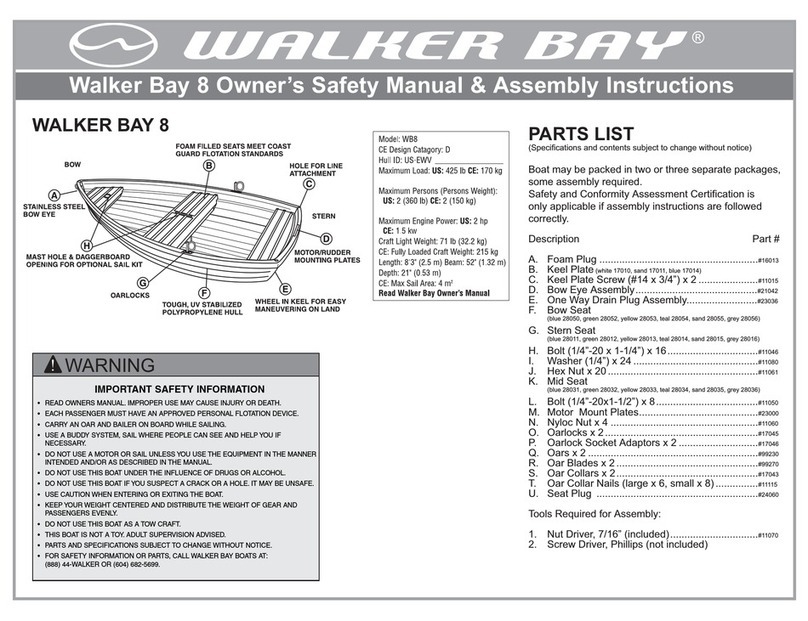
Walker Bay
Walker Bay 8 Owner's safety manual & assembly instructions
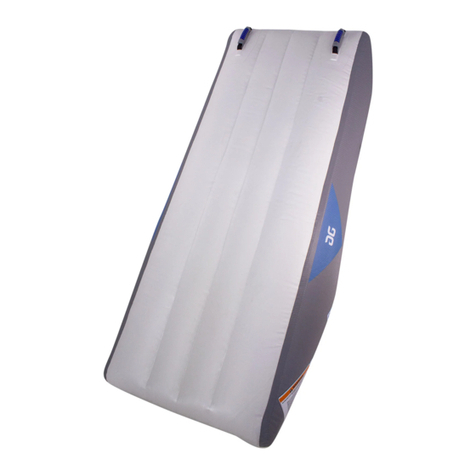
Aquaglide
Aquaglide 16-17 SLIDE (LARGE) owner's manual
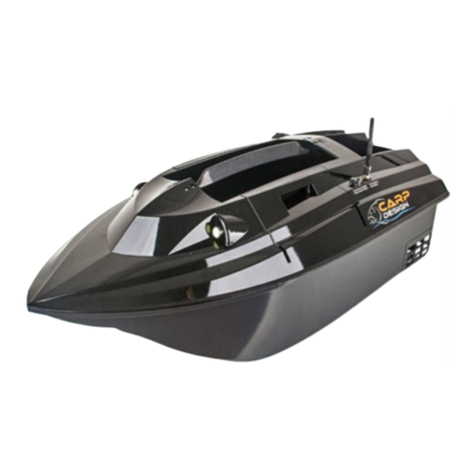
Gediao
Gediao Carp Design V80 Product Operation Instruction

Cobalt Digital Inc
Cobalt Digital Inc R3 BOWRIDER owner's manual
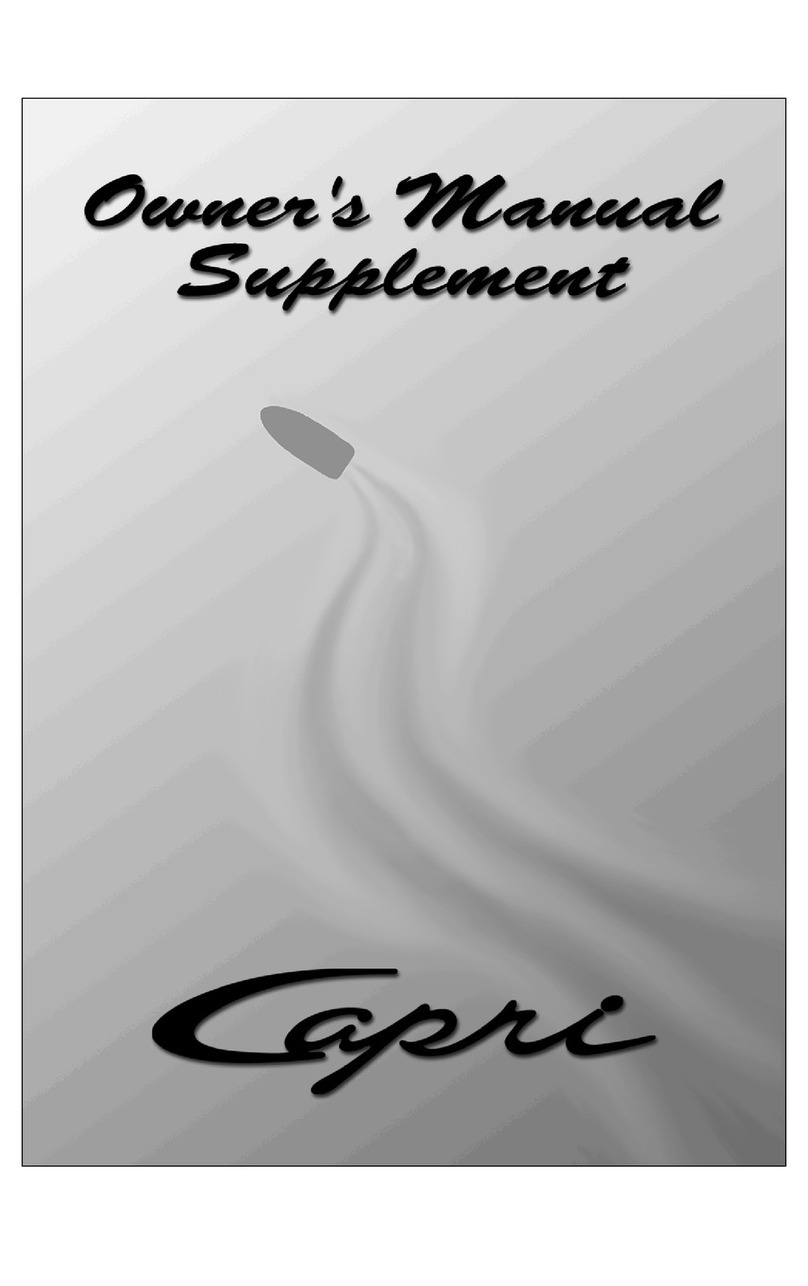
Bayliner
Bayliner Capri Owner's manual supplement

Horizon Yacht Charters
Horizon Yacht Charters Bavaria 39 'Sawsea Lady' 2006 Information & operation manual
